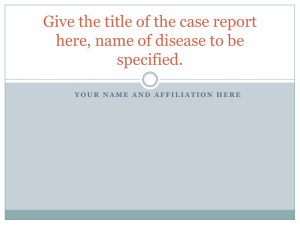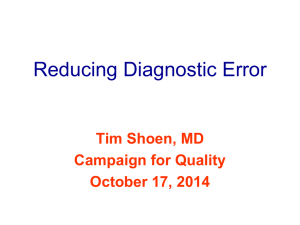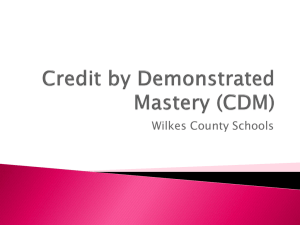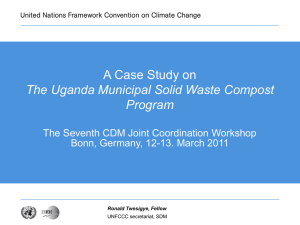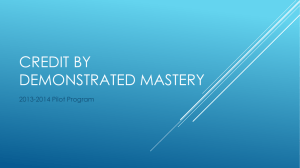Introduction to CDM - Scottish Intensive Care Society
advertisement
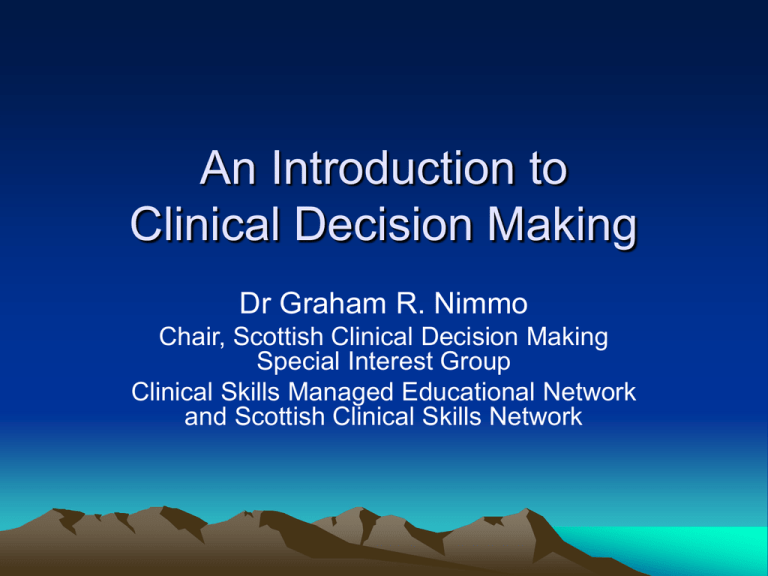
An Introduction to Clinical Decision Making Dr Graham R. Nimmo Chair, Scottish Clinical Decision Making Special Interest Group Clinical Skills Managed Educational Network and Scottish Clinical Skills Network Overview • Intro to clinical decision making (CDM) • The five second rule: a case based CDM challenge • How do we think and make decisions? • What affects our CDM? • How can we improve CDM and enhance patient safety? • Next? CDM and non-technical skills • • • • Team working Decision making Situation awareness Task management • Diagnosis • Prognosis CDM exercise 1 • Think about your choice of speciality, profession, job • What influenced you in that decision making? CDM exercise 2 Look at the next slide and ask yourself: • “Which beach would I rather be on?” A or B? CDM in the acutely ill • • • • 21 year old with known asthma In respiratory ward Phone call Decisions • Recognition The five second rule CDM in the acutely ill • • • • • In the ward Assessment and management Looks…. Obs…. Actions System 1 thinking: (intuitive) Cognitive style Cognitive awareness Cost Automaticity Rate Reliability Errors Effort Predictive power Emotional component Scientific rigour Heuristic Low Low High Fast Low Usually Low Low High Low Importance of CDM in managing sick patients • Patients still die from ‘simple’ things either missed, delayed or done sub-optimally • Decisions including diagnosis • Approx 80% of clinical time spent in the cognitive domain THE FOUR KEY DOMAINS OF EMERGENCY CARE 1. Acute assessment + stabilisation with immediate investigations and support. Targeted secondary exam 2. 3. 4. Monitors: reassess CDM Differential diagnosis/ definitive diagnosis Surface Invasive Real time or Delayed Illness severity Team work Task Mx Situation Awareness Critical Thinking Immediate, medium term and long term treatment 1. Advanced First Aid • • • • ASSESSMENT Hello, how are you ? Response Airway: patent ? Breathing • • • • ACTION Look: obstruction Listen: ? noise Clear or secure: headtilt/chin lift or jaw thrust? Airway: oral or nasal? High concn oxygen: mask type? Flow? 1. Advanced First Aid ASSESSMENT • • • Sounds ? Common 3 are ? Causes are ? ACTION • Clear and keep open • Get help 2222? • Advanced airway management required? Tracheal tube? Size? Cut to what length? Are drugs needed for anaesthesia and intubation? If yes, which? 1. Advanced First Aid ASSESSMENT Sounds • Nil: complete obstruction or not breathing • Snoring/gurgling: reduced GCS, foreign material • Stridor: anaphylaxis, burns/thermal; tumour; abscess/infection For each ask ‘what is the diagnosis?’ ACTION • • • • Clear and keep open Get help 2222 Positioning Advanced airway management required 1. Advanced First Aid plus 2. • • • • • • OBSERVE Rate Volume Symmetry Character Work of breathing Compromise Ix & MONITOR • CXR, PEFR, ABGs • Repeat observations • Pulse oximetry • TREAT • Oxygen • Nebulisers 1. Advanced First Aid ASSESS • Pulse: which pulse? PHYSIOLOGY • MAP = CO x SVR • Skin: cap refill time, temperature • CO = HR x SV • BP: where? Which method? • Low BP = decompensation 1. Advanced First Aid iv access • Site • Size • Blood sampling iv access • Upper limb Femoral • High flow: short and thick • Fluids • Drugs Wide bore peripheral cannulae 1. Advanced First Aid • • • • Disability ? Conscious level, focal neurology DEFG Difficult bit IMMEDIATE INVESTIGATIONS • • • • Arterial blood gases: O2, CO2, acid-base Potassium Glucose can all be done on a Haemoglobin blood gas sample • 12 lead ECG • CXR • Targeted investigations • What should we do having analysed this information? 1. Advanced First Aid • • • • Evidence Environment: context Targeted secondary Examination Explanation • Everything else… Advanced First Aid=Phase 1:abcde • abcde, treating as you go • Repeated assessment and continuous monitoring: patient better or worse ? • Do we need enhanced abcde ? • Targeted secondary examination THE FOUR KEY DOMAINS OF EMERGENCY CARE 1. Acute assessment + stabilisation & immediate investigations and support. Targeted secondary exam 2. 3. 4. Monitors: reassess CDM Differential diagnosis/ definitive diagnosis Surface Invasive Real time or Delayed Illness severity Team work Task Mx Situation Awareness Critical Thinking Immediate, medium term and long term treatment Illness Severity Assessment • Speed of action needed • Level & type of expertise: resuscitation; diagnostic; therapeutic • Where should the patient be ? Nursing intensity, monitoring, medical input? • Definitive treatment: speed ? SEVERITY SCORING 1:CLINICAL • • • • • ABNORMAL PHYSIOLOGY OBSERVATIONS Airway compromised Resp rate Pulse rate SBP GCS • • • • • Bad <10 or >30 <45 or >120 <100 (110) or >200 Fall of 2 points, <15 SEVERITY SCORING 2: INVESTIGATIONS ABNORMAL INVESTIGATIONS • • • • • • • Hypoxaemia Hypercarbia Potassium Glucose H+ Base excess Lactate RESULTS • • • • • <3 or >6 (ECG) <3 or >20 >50 or <30 < -5 or > +10 Diagnosis ? Relationship between base excess and mortality in ICU Base Excess and Mortality Red = Dead Green = survivor ICM 2001;27:74-83 SEVERITY SCORING 3: organ failures • Clinical: cardiovascular (shock) • CNS reduced conscious level • Urea and creatinine: renal • ABGs: respiratory (oxygenation+/or CO2 clearance) • Clotting: coagulation • WBC: bone marrow • Gut/liver: glucose; lactate; clinical 4. Differential Diagnosis, ultimate diagnosis and definitive treatment • Get more history • Trachea • Chest • JVP and heart • Abdomen • Skin, CNS • GP, family, SAS • Deviation • Lateralising signs, wheeze, crackles • HS III or IV, murmurs • Swelling, pulsation • Rashes, neck stiffness, lateralising signs ASSESSMENT • A clinical + • B investigations + • C organ failures + • D diagnosis Decision making • • • • • • • Diagnosis (and treatment) Is the diagnosis correct (complete) ? Prognosis Admit ? Discharge ? Stop ? Distributed Diagnostic Error • Ranked 2nd cause of adverse events (Harvard study, 1991) • Diagnostic failure highest in EM, GP, Gen Med • Passing on to specialists in wards, ICU • 2/3 of claims against UK GPs are for diagnostic failure Type 2 thinking (analytical) Cognitive style Cognitive awareness Cost Automaticity Rate Reliability Errors Effort Predictive power Emotional component Scientific rigour Systematic High High Low Low High Few High High Low High Diagnosis • History: full • Examination: complete • Investigations • Differential Dx • Treatment • Refine diagnosis Categorising Clinical Decision Making • Cognitive theory: traditional • Technical • Professional • Distributed Traditional cognitive taxonomy or “how you think it” • • • • Problem solving Pattern recognition Decision analysis theory Hypothetico-deductive reasoning CDM: a universal model of diagnostic reasoning • • • • • • • Intuitive Experiential-inductive Bounded rationality Heuristic Pattern recognition Hard wired response Thin slicing Unconscious thinking theory • • • • • • • Analytical Hypothetico-deductive Unbounded rationality Normative reasoning Robust CDM Acquired, critical, logical thought Multiple branching/arborisation Deliberate, purposeful thinking A or B? CDM What affects clinical decision making ? • Knowledge and skills • Behaviours: attitude (multiple selves), emotions (affect: self, family, patients, relatives, colleagues), values. What affects clinical decision making ? • • • • • • • • • Context Values Affect Knowledge Critical thinking Interruptions Clinical reasoning Words Non-technical Skills • • • • • • • • • • Physical factors Stress and Fatigue Ergonomics Experience What we hear What we think Cognitive biases Heuristics Epiphanies Geography 30 Cognitive Errors after Croskerry Aggregate bias Anchoring Gender bias Hindsight bias Psych-Out Errors Representativeness Ascertainment bias Multip.Alternatives Search satisficing Availability Omission bias Sutton’s Slip Base rate neglect Order effects Triage-Cueing Commission bias Outcome bias Confirmation bias Overconfidence Diagnostic creep Playing the odds Attribution error Posterior prob. Gambler’s Fallacy Premature closure Unpacking principle Vertical line failure Visceral bias Ying-Yang Out Zebra retreat Hard wiring Heuristics and Biases Ambient conditions/Context Task characteristics Age and Experience Affective state Gender Personality TYPE 1 RECOGNIZED Patient Presentation Pattern Processor processes Pattern Recognition Repetition NOT RECOGNIZED TYPE 2 processes Intellectual ability Education Training Critical thinking Logical competence Rationality Feedback Rational override Dysrationalia override Calibration Diagnosis THE FOUR KEY DOMAINS OF EMERGENCY CARE 1. 2. Acute assessment + stabilisation & immediate investigations and support. Mons: reassess Targetted secondary exam Surface Invasive Real time or Delayed Tissue hypoxia 3. 4. CDM Differential diagnosis/ definitive diagnosis Team work Task Mx Situation Awareness Critical Thinking Immediate, medium term and long term treatment Clinician factors: Evidence Based judgment , affect, Medicine experience Patient Factors Solutions • Training in critical thinking • Training in major cognitive and affective biases • Training in logical thought • Awareness of self and metacognition • Timely feedback • Training in cognitive forcing strategies



